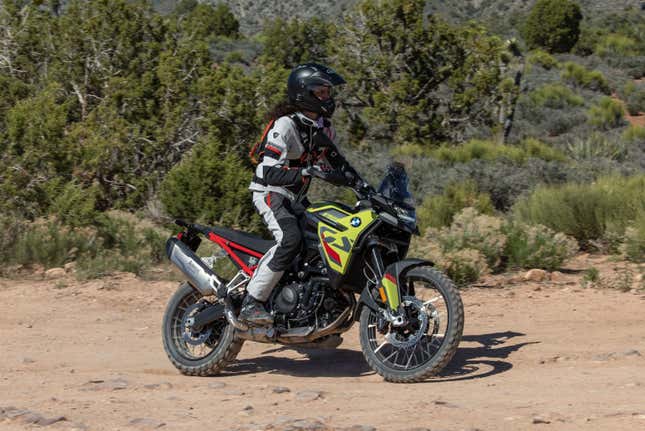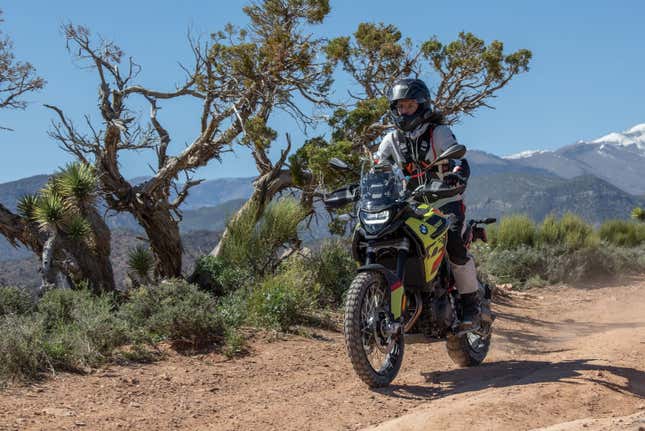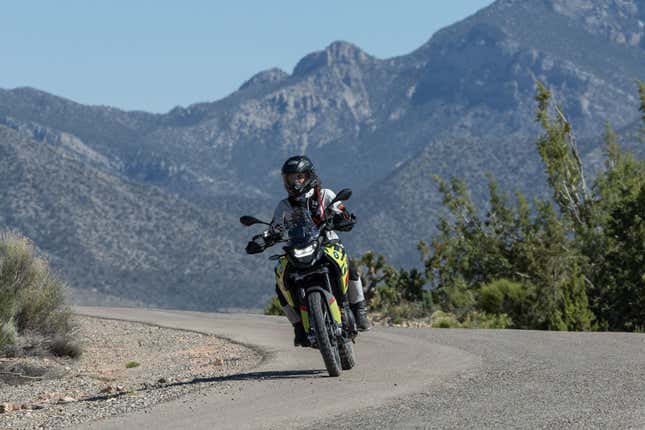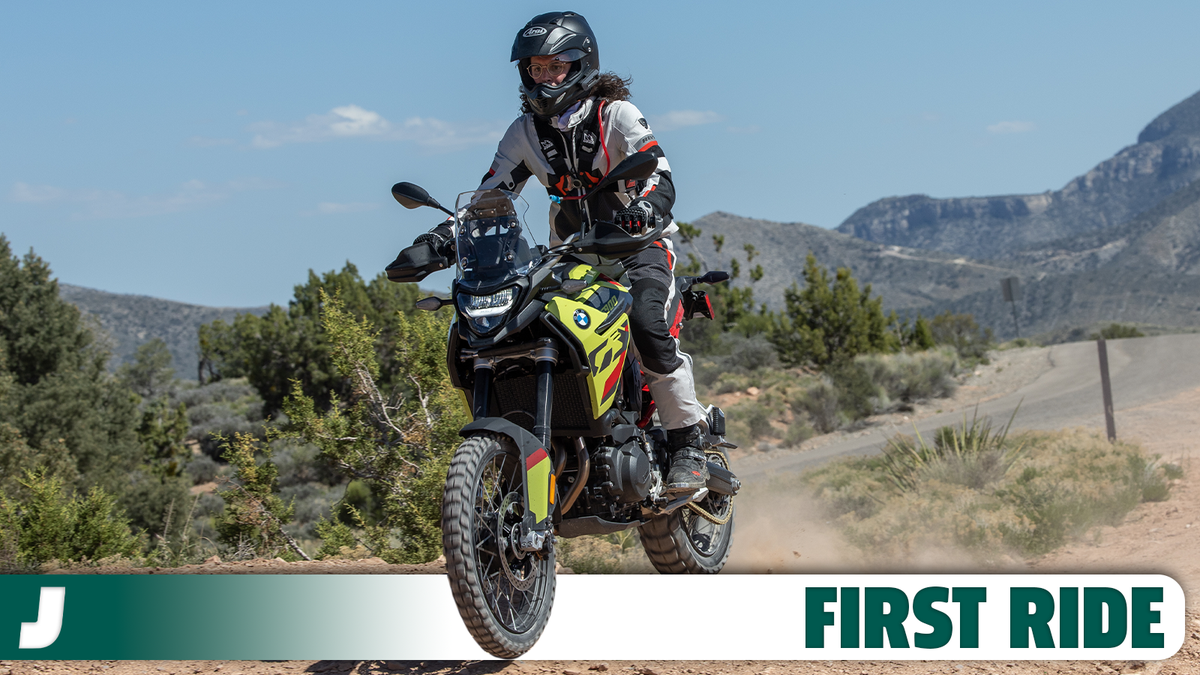BMW’s GS line of adventure motorcycles has done everything. These bikes have circled the globe, racked up hundreds of thousands of miles, and visited some of the most remote places on the planet. But when a bike is too omnicapable — too good at everything, too often the objectively correct choice — it becomes boring. It’s the struggle of the late-’90s Yankees or early-’00s Patriots: When you’re always expected to win, your victory is just never that interesting.
For the F900GS, though, BMW changed up that formula. This is not a staid highway tourer with some dirt chops, a chassis built to be all things to all people at all times. It’s something that is, in many ways, actually worse than the F850GS it replaces, which makes it so much more fun.
Full Disclosure: BMW shipped me out to Las Vegas, Nevada to rip the F900GS and CE02 through the city streets and desert sand. Despite being only April, it was one of the hottest experiences of my life. The company paid for my airfare, lodging, and meals.

BMW says the F900GS is a successor to the outgoing F850, and the spec sheet shows some nice changes from that old model: The new bike’s bored-out engine claims 105 horsepower and 68.6 pound-feet of torque, increases of 15 hp and 5.6 lb-ft from the old bike, and a 22-pound weight reduction brings the F900GS down to 482 pounds wet. There’s still a beak, if you really squint looking for it, and the option sheet is full of typical modern BMW accoutrement. Ride modes, GPS prep, keyless ride, heated grips and that Akrapovič muffler are standard. It all starts at $13,500, but you’re not likely to find one on a dealer lot for under $16,000. Sounds like a GS, right?
Yes, but not the one you’re thinking of. See, BMW’s not exactly right when it claims the F900GS just follows in the F850’s footsteps. In reality, the bike harkens back to something long dead in the company’s lineup: The 2000-2008 F650 Dakar, a bike that threw out street comfort and performance in favor of all-out dirt capability. While the F900 doesn’t have a low-horsepower single-cylinder engine or an exhaust tucked up under the seat, it hews closer to that dirt-focused predecessor than one might expect.
The F900GS sheds much of the classic GS styling in favor of something more enduro, and it looks better for it. I’ve always thought the mismatched headlights of the F850 and my own F800 look a bit dweeby, but the F900 looks fantastic from every angle — the headlight, which I was so unsure about on launch, won me over in real life. The rear end is slim and lightweight, and the tail light assembly is so minimal that I genuinely wonder how it’s legal on American roads. There are just two taillights that handle illumination, turn signaling, and brake lighting, which can make that third one a little difficult to discern in real-life riding. Worth it, though, for the clean look.

To follow that styling, BMW declares the F900GS is more focused on off-road performance than anything else. Suspension travel is up more than a full inch in the front, for over 9 inches on the forks and just under 8.5 in back, and a slew of ergonomic upgrades are targeted specifically at riders who spend their time on two feet rather than one seat. Think about it this way: It’s a GS that offers factory bar risers, but doesn’t offer vibration-damping rubber in the foot pegs.
In the dirt, all those changes make for a highly confidence-inspiring ride. The bike feels narrow between the legs relative to other ADVs, and it goads you into pressing just that little bit further into the dirt or gravel. Off the pavement, the weak point in this bike’s system is clearly me as its rider, but it still convinced me to tackle terrain I really had no business attempting — at least, not in the Nevada desert heat.
The GS’s suspension definitely felt stiff through the gravel, but even the base bike is adjustable for preload and rebound damping on the rear shock and the front forks, with the front also getting a dial for compression. I was warned when setting off that it was dialed for a heavier rider than I, and heavier riders on the trip didn’t share all of my complaints. For the most hardcore of dirt riders, though, BMW offers a further upgrade: The sport suspension of the Enduro Package Pro, with meatier front forks and a more adjustable rear shock.

But where the F900GS gains dirt-ready styling, suspension, and ergonomics over its predecessor, it loses street comfort in the exchange. City streets and twisty back roads aren’t the issue. The engine is a gem on tarmac, eagerly winding out all 105 of those horses, and the suspension still inspires confidence through a surprisingly chilly mountain full of curves. It wants to lean over, enjoys powering out of a corner, and is happy to show that dirt performance doesn’t mean sacrificing fun once the pavement starts.
The issue comes when you try for the latter half of that oft-abbreviated segment name: Adventure touring. For long highway stints, all those ergonomic changes that make the F900GS stand out in the dirt suddenly become a pain. The narrow seat that felt so slim between the legs off-road starts to dig into your pelvis, and those serrated foot pegs send an engine’s worth of vibrations through your boots. The bars, too, are surprisingly vibrational at highway speeds.
The worst part about highway riding on the F900GS, though, has to be the windscreen. I’m traditionally not a fan of stock windscreens, but this one made for some of the loudest riding I’ve ever had on a motorcycle. Wind pounded my helmet constantly, and it made me truly take notice of my Arai XD-4’s sun peak when it caught air pressure during shoulder checks.

Of course, these issues are fixable. BMW offers other seats and windshields, and aftermarket suppliers are already putting their own takes together. (Puig had a windshield available before I even swung a leg over the F900GS.) The bike’s foibles are things the aftermarket can easily pick up, and the harder-to-change aspects — the engine, the suspension, the rider triangle — are fantastic.
Rather than follow in the footsteps of the do-everything F850, the F900GS wants to be an enduro first and an ADV second — the word “enduro” outnumbered “ADV” in BMW’s product presentation at the launch event nearly two to one. It’s worth wondering whether a 483-pound bike with two cylinders and 105 horsepower can ever really fit into such a lightweight segment, but there also isn’t really a word for the more dirt-oriented side of adventuring, such as bikes like your KTM 890 Adventure R or Tenere 700.
The BMW F900GS is a joy to ride in the dirt or on a twisty back road, and tolerable on the highway. It’s a new face for the GS line, both literally (with its finally-symmetrical front end) and metaphorically, for a brand that’s long been derided with accusations of “tarted up touring bike.” Rather than doing everything blandly, the F900GS has a specialty to its design that lends character to the rest of the riding experience. If I had $16,000 to spare, I know which bike in the segment I’d buy.

